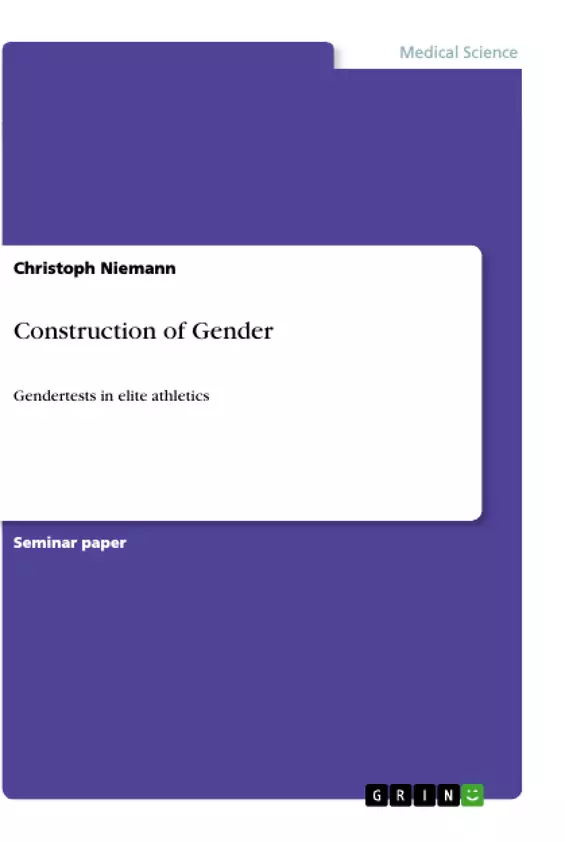In the context of this thesis the topic of the gender construction is taken up. Subject areas of the social and natural sciences try to find the causes of the gender-specific differences with the aid of various theories. At first, an analysis of the relationship
between society, gender and sport should make it clear how the social subsystem Sport was influenced and structured by everyday theory. Using the example of the controversial phenomenon of sex tests in sport, it should be shown that the gender
of a person cannot be measured using biological-medical criteria only. This thesis is contrary to the widespread opinion in medicine and biology that sex can be clearly determined based on five criteria. Therefore, a fundamental understanding of the
procedure and basics of gender testing should be created by summarizing these criteria. In a second step, it is shown that it is possible by a social-scientific point of view to question hypotheses of a purely biological, pre-social nature of man. A basic insight is that the society in which we live is a result of our own actions.
At first glance, the question of a person’s gender acts as if the answer is obvious. Gender is one of the central structural principles of our society. The population consists of women and men, girls and boys. There is a social system of the two sexes
and sex seems to be given by nature. In everyday life it is associated with the idea of a recognizable and invariable distinction between woman and man. This is closely linked to the assumption of gender polarity. Thus, there are assumptions of different
characteristics and behaviors, as well as a natural gender hierarchy and performance.
Girls play with dolls, put on make-up, wear pink clothes and are especially tender and sensitive. Boys, however, are ambitious and self-reliant, playing with toy cars and crafts. But the fact that this societal system received such great social significance
for the two sexes is not based solely on the natural conditions. Rather, it is a social order that has developed in our society since the eighteenth century and has been proven by biology and medicine since the nineteenth century. An understanding
was developed by supposedly scientifically precise facts of the natural sexual characteristics of women and men.
Inhaltsverzeichnis (Table of Contents)
- Introduction
- Relationship between society, gender and sport
- Gender verification in sports
- Socio-historical background
- The genesis of the biological sex
- The genesis of the social sex
- Procedures in sports
- The challenge of intersexuality
- Summary
- Bibliography
Zielsetzung und Themenschwerpunkte (Objectives and Key Themes)
This thesis aims to analyze the construction of gender in elite athletics, specifically focusing on the controversial phenomenon of gender verification tests. It explores the relationship between society, gender, and sport, demonstrating how the social system of sport has been influenced and structured by everyday theory. Using the example of sex tests in sport, the thesis argues that gender cannot be measured using solely biological-medical criteria. It critiques the widespread opinion in medicine and biology that sex can be clearly determined based on five criteria and examines the social and cultural factors that contribute to the categorization of gender.
- The construction of gender in society and sport
- The impact of social and cultural norms on gender categorization
- The limitations of biological-medical criteria for determining gender
- The historical and social context of gender verification tests in sport
- The social and scientific understanding of intersexuality in relation to gender classification
Zusammenfassung der Kapitel (Chapter Summaries)
- Introduction: This chapter introduces the topic of gender verification in elite athletics through the case of Caster Semenya. It highlights the societal expectations and assumptions surrounding gender, particularly in the context of sport. It also discusses the social and biological influences that contribute to our understanding of gender.
- Relationship between society, gender and sport: This chapter explores the historical development of the relationship between society, gender, and sport. It examines how gender became a structuring principle in modern society and how this influenced the participation of women in sports. The chapter delves into the historical perspectives on women's physical abilities and the limitations imposed on their participation.
- Gender verification in sports: This chapter focuses on the socio-historical background of gender verification in sports, highlighting the increasing participation of women in competitions and the need for a clear classification system. It explores the rise of sex tests in sport, tracing their historical evolution and the motivations behind their implementation. The chapter also discusses the limitations and ethical implications of sex tests.
Schlüsselwörter (Keywords)
The primary keywords and focus topics of this thesis include: gender, sport, sex, intersexuality, gender verification tests, gender construction, social construction, biological sex, social sex, societal norms, athlete, Olympics, IAAF, IOC.
- Quote paper
- Christoph Niemann (Author), 2019, Construction of Gender, Munich, GRIN Verlag, https://www.grin.com/document/1168763



